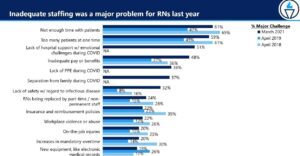Information Management-Nursing Staffing Shortages in Massachusetts
Staffing levels of nurses are critical in the optimization of patient care of the highest quality, improvement of care outcomes, and cost containment in the long term. In the background of patient complexity, an aging population, and nurse staffing shortages, appropriate levels of staffing have the benefits of reduced rates of mortality, reduced patient stay durations, and reduced number of preventable events such as infections and falls. The State of Massachusetts has had a long battle with nurse staffing shortages.
A survey of over 500 nurses in Massachusetts published at the commencing of the National Week indicated that in the last year (2020), nurses experienced poor patient care quality in hospitals. These were coupled with unsafe patient assignments, limited time with patients, and worsening workplace safety. One of the nurses commented that the corporate takeover of the healthcare system in the state, whether by large NGOs or for-profit companies that pay millions to their executives, has ended up hurting the frontline healthcare workers and nurses’ ability to provide quality care for patients (Massachusetts Nurses Association (2021). The other issues raised by the nurses in the survey are summarized in the graph below:

Source: Massachusetts Nurses Association (2021)
In their research article, MIT Sloan (2021) indicates that nursing facilities in Massachusetts continue to face shortages at critical levels, with approximately 4000 direct care nursing staff short. The researchers suggest that the state can meet the need through a competitive living wage, continued support of the opposition of RCA, and training for certified nursing assistants widely affordable and acceptable through online platforms and partnerships with local training providers and vocational training and community colleges. Taking these steps will ensure that caregivers are sufficient in numbers to meet the needs of patients.
After the pandemic hit hard in 2020, the government of Massachusetts leaders continued to make the necessary Medicare and Medicaid payment system investments to fund the increase in wages for healthcare staff. Leaders have also adopted public initiatives and policies that address the staff shortage problem that has gone on for decades.
In 1999, California (CA) passed and implemented 2004 the first state legislation, which is still the only one in the country. The legislation limits the number of patients that a nurse is allowed to care for at any given time. In Massachusetts, a ballot issue arose in 2018 that would improve staffing shortages in hospitals. However, the ballot failed because of the lack of credible evidence at the local level that showed that the legislation would be in the public’s best interest and would not cause any disruptions to care access (Chen,2018; Fotsch, 2019).
Key Quality Improvement Tools
According to the Massachusetts Department of Higher Education (2021), the purpose of developing the Nursing and Allied Health Initiative in 2005 was to address nurse staffing shortage and nurse faculty shortage as well. Seven years later, the Department of Higher Education, along with the campus partners, industry associates, and care providers, initiated the public/private partnership that addressed the workforce needs both on a short and long-term basis and also tackled the program and curriculum systemic capacity challenges. The Nursing and Allied Health Workforce Development Plan contains the proposals and accomplishments as well as the plans of the partnership. The project includes the future directions of the nursing programs offered in the private and public education system, as well as employer partners in the role of transforming the current and future workforce in response to the healthcare system’s changing landscape.
Additionally, healthcare facilities should consider individual departments in a healthcare facility to have a formal staffing plan that ensures every patient receives care from the most appropriately skilled nurse. A staffing plan refers to the shift and unit-specific strategy of scheduling that supports departmental care standardization (Griffiths et al., 2020). In attempting to decrease nurse turnover, healthcare facilities should consider limiting mandatory overtime, delegating to other qualified staff the paperwork, improving workflow by adopting up-to-date technology, and offering competitive compensation in line with a nurse’s experience (Shaffer & Curtin, 2020). Lastly, having a staffing committee will allow a healthcare facility to take a collaborative staffing approach (McDonald, 2019). The committee will provi
